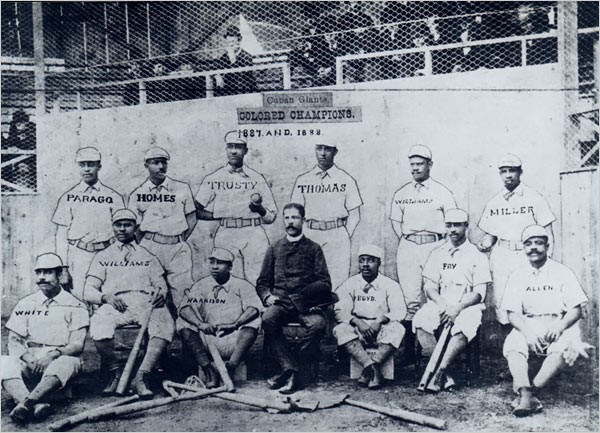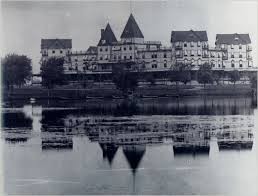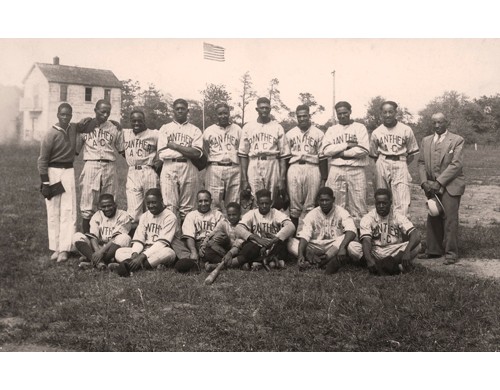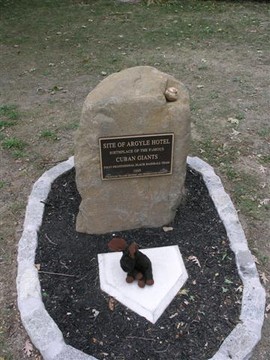Babylon Argyle Hotel (1882-1904) and the Cuban Giants Baseball Club
Introduction
Text-to-speech Audio
Argyle Park commemorates the history of the Babylon Hotel which was located here and was the birthplace of the Cuban Giants, the first African American professional baseball team. A group of players from several different amateur baseball teams, many of whom worked at the Argyle to hash out the plans for the team in 1885. The original name for the team was the Babylon Black Panthers. The players were all service workers for the upscale hotel which catered to wealthy vacationers from New York City.
Images
Cuban Giants team photo

Argyle Hotel

Original team photo of the Cuban Giants when they were named the Black Panthers.

This plaque serves as a monument commemorating the formation of the Cuban Giants.

Backstory and Context
Text-to-speech Audio
The Cuban Giants were the first African American professional baseball club and were formed in 1885 at the Argyle Hotel, a summer resort in Babylon, New York. The team was so skilled in the game that they defeated most of their opponents- most of whom were nearby amateur "white" teams. This led to the attention of promoter, Walter Cook. To appeal to a broader audience, Cook styled the team as the "Cuban Giants" to reduce tensions related to the Black/white racial divide. Of course, few if any of the players were from Cuba and this was related to many other efforts to blur the color line.
The team remained one of the premier African American teams for nearly 20 years and defeated many other African American teams leading to the title of "World Colored Champions" in 1887 and 1888. The success of the team spawned imitators as well as nearly a century of premiere Black teams using the name "Cuban" as part of their name as part of their effort to attract white fans who might otherwise not enjoy watching talented local Black athletes.
The famous Argyle Hotel in Babylon was one of many luxury hotels constructed in the late 19th century to accommodate wealthy summer visitors from New York City. It was constructed in 1882 by August Belmont, a resort entrepreneur, and built upon the former estate of Brooklyn railroad magnate Electus B. Litchfield. Financing was provided by a syndicate headed by Long Island Rail Road President, Austin Corbin.
The grounds of the hotel included a large millpond, Blythebourne Lake, which was renamed Argyle Lake as a tribute to one of the hotel’s largest investors and town aristocrat, the heir to the Dukedom of Argyll. The renaming gave the Hotel & Park a more genteel English flavor yet the hotel proved a bad venture: it was near the end of the era of such projects, it was built much too large with 350 rooms, and so was rarely more than one-third filled. After about a decade of disuse, it was finally demolished in 1904, some of the structure being used to build homes west of the lake in the neighborhood now known as Argyle Park.
In 1921, the land that is now the Argyle Park was donated for passive recreation to the Village of Babylon, by J. Stanley Foster,Esq. This park is still popular, drawing substantial numbers of visitors from outside the community for fishing, strolling, playing on the children's playground, and winter ice skating. This hotel and its employees are largely responsible for integration in sports and giving people like Jackie Robinson a place to play.
The team remained one of the premier African American teams for nearly 20 years and defeated many other African American teams leading to the title of "World Colored Champions" in 1887 and 1888. The success of the team spawned imitators as well as nearly a century of premiere Black teams using the name "Cuban" as part of their name as part of their effort to attract white fans who might otherwise not enjoy watching talented local Black athletes.
The famous Argyle Hotel in Babylon was one of many luxury hotels constructed in the late 19th century to accommodate wealthy summer visitors from New York City. It was constructed in 1882 by August Belmont, a resort entrepreneur, and built upon the former estate of Brooklyn railroad magnate Electus B. Litchfield. Financing was provided by a syndicate headed by Long Island Rail Road President, Austin Corbin.
The grounds of the hotel included a large millpond, Blythebourne Lake, which was renamed Argyle Lake as a tribute to one of the hotel’s largest investors and town aristocrat, the heir to the Dukedom of Argyll. The renaming gave the Hotel & Park a more genteel English flavor yet the hotel proved a bad venture: it was near the end of the era of such projects, it was built much too large with 350 rooms, and so was rarely more than one-third filled. After about a decade of disuse, it was finally demolished in 1904, some of the structure being used to build homes west of the lake in the neighborhood now known as Argyle Park.
In 1921, the land that is now the Argyle Park was donated for passive recreation to the Village of Babylon, by J. Stanley Foster,Esq. This park is still popular, drawing substantial numbers of visitors from outside the community for fishing, strolling, playing on the children's playground, and winter ice skating. This hotel and its employees are largely responsible for integration in sports and giving people like Jackie Robinson a place to play.
Sources
White, Sol. Malloy, Jerry. History of Colored Baseball with Other Documents on the Early Black Game, 1886–1936. Edition 1996 Reprint. Lincoln, NE. Bison Books, 1996.
